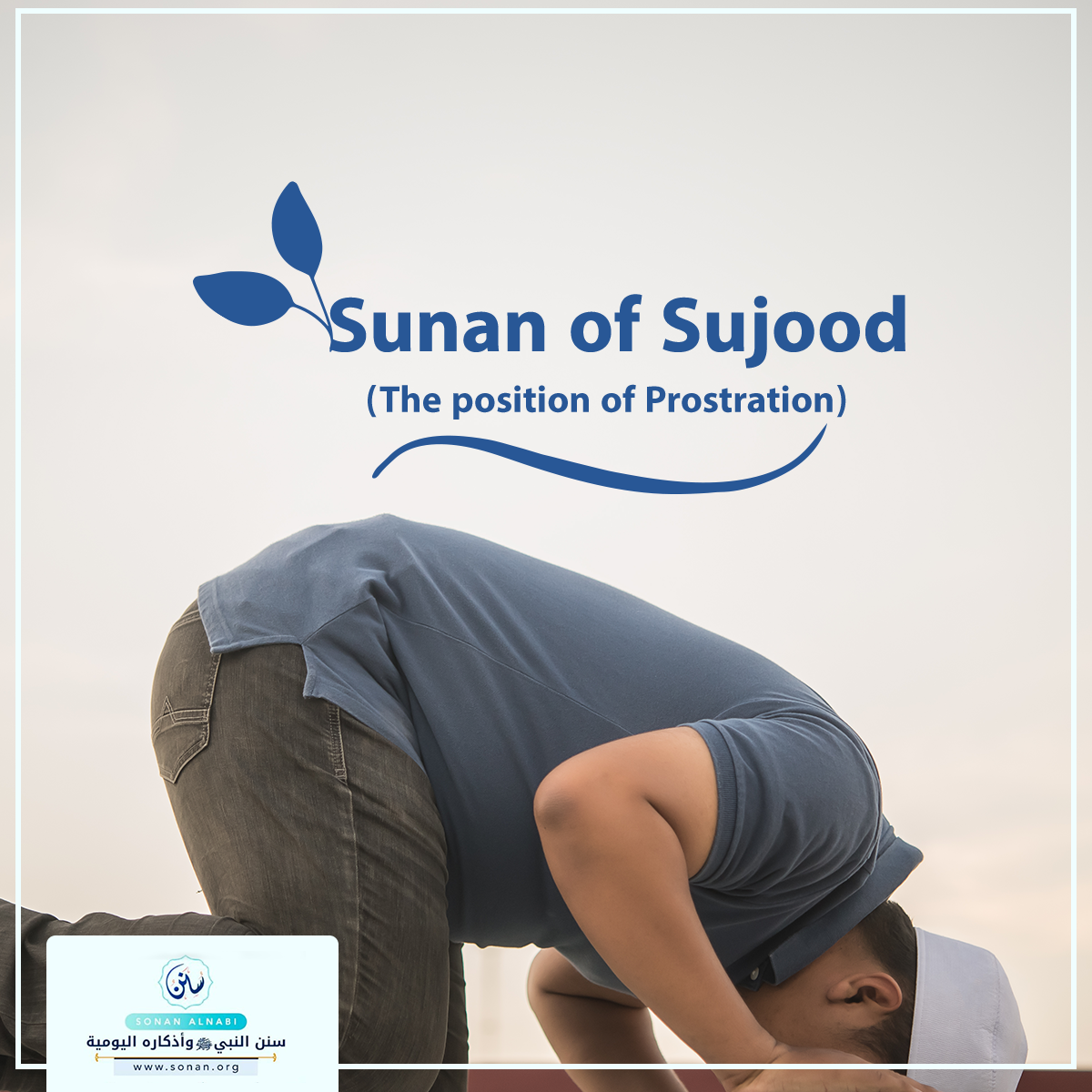Search
Sunan of Sujood (The position of Prostration).

Number 1 of Sunan of Prostration
1. Keeping a distance between the arms and the side, and between the thighs and the belly while prostrating.
‘Abdullāh Ibn Baheenah (ABPWH) narrated,
“When the Prophet (PBUH) prostrated, he used to keep his arms so wide apart that we used to see his armpits.”
(Al-Bukhāriy no. 390, Muslim no. 495).
Besides,
Maymoonah, may Allāh be pleased with her, narrated,
“When the Prophet (PBUH) prostrated, he would make the space between his arms and sides such that it would allow a sheep to get through.”
(Muslim no. 496).
This indicates that it is Sunnah to exaggerate in positioning the arms wide apart, provided this would not cause any harm to those praying next to one another, similar to what was mentioned about spreading the elbows away from the body in Rukoo‘.
It is also Sunnah to keep the thighs away from each other when prostrating.
Abu Humayd narrated,
“He kept his thighs wide and did not let his belly touch his thighs.”
(Abū Dāwood no. 735)
It is agreed upon by all Scholars that this is Sunnah as reported by Imām Ash-Shawkāniy and others.
Ash-Shawkāniy, may Allāh have mercy on him, said, “This Hadeeth indicates that it is permissible to widen the space between the thighs during prostration, keeping them a distance away from the belly, and this is agreed on between the Scholars.” (Nayl Al-Awttār, 2/547)
Number 2 of Sunan of Prostration
2. Ensuring the toes point towards the Qiblah while prostrating.
Abu Humayd reported,
“I am the one who is most knowledgeable about the Prophet’s (PBUH) prayer.” Abu Humayd then said in the same Hadeeth, “When he wanted to prostrate, he would place his hands on the ground neither stretching them nor grasping them and he would place his toes pointing towards the Qiblah.”
(Al-Bukhāriy no. 828)
As for the position of the fingers during prostration, it is Sunnah to keep them extended straight, tight together, and pointed towards the Qiblah.
It was reported in Al-Muwatta’ by Imām Mālik that ‘
Abdallāh Ibn ‘Umar, may Allāh be pleased with them, said,
“It is Sunnah to extend the palms of the hands straight, tighten between the fingers, and place the palms of the hands on the ground, with the fingers pointing towards the Qiblah.”
(Mussannaf of Ibn Abi Shaybah, 1/236)
Number 3 of Sunan of Prostration
3. Saying the Adthkār of Sunnah in prostration.
The following are some of the Adthkār of Sunnah that can be uttered after the obligatory supplication of prostration
{ سبحان ربي الأعلى }
“Glory to my Lord the most High.”:
« سُبْحَانَكَ اللَّهُمَّ رَبَّنَا وَبِحَمْدِكَ، اللَّهُمَّ اغْفِرْ لِي »
This is taken from the Hadeeth of ‘Ā’ishah, may Allāh be pleased with her.
“Glory and praise be to You, O Allāh our Lord, I ask You your forgiveness.”
(Al-Bukhāriy no. 794, Muslim no. 484)
« سُبُّوحٌ قُدُّوسٌ رَبُّ الْمَلاَئِكَةِ وَالرُّوحِ »
This supplication was narrated in the Hadeeth of ‘Ā’ishah, may Allāh be pleased with her.
All-Glorious, All-Holy, Lord of the angels and spirit.”.
(Muslim no. 487)
« اللَّهُمَّ لَكَ سَجَدْتُ ، وَبِكَ آمَنْتُ ، وَلَكَ أَسْلَمْتُ ، سَجَدَ وَجْهِي لِلَّذِي خَلَقَهُ وَصَوَّرَهُ، وَشَقَّ سَمْعَهُ وَبَصَرَهُ، تَبَارَكَ الله أَحْسَنُ الْخَالِقِينَ »
This supplication is narrated in the Hadeeth of ‘Aliy (ABPWH).
“O Allah, to You I prostrated, in You I believe, and to You I submit. I prostrate my face to the One Who created it and gave it hearing and sight. Glory is to Allah, the Best of creators.”
(Muslim no. 771)
« اللَّهُمَّ اغْفِرْ لِي ذَنْبِي كُلَّهُ دِقَّهُ وَجِلَّهُ ، وَأَوَّلَهُ وَآخِرَهُ، وَعَلاَنِيَتَهُ وَسِرَّهُ »
This supplication was narrated in the Hadeeth of Abi Hurayrah (ABPWH).
“O Allāh, forgive all of my sins, those that were small and those that were big, and those done in public and those done in secret.”
(Muslim no. 483)
« اللَّهُمَّ إِنِّي أَعُوذُ بِرِضَاكَ مِنْ سَخَطِكَ ، وَبِمُعَافَاتِكَ مِنْ عُقُوبَتِكَ ، وَأَعُوذُ بِكَ مِنْكَ ، لاَ أُحْصِي ثَنَاءً عَلَيْكَ ، أَنْتَ كَمَا أَثْنَيْتَ عَلَى نَفْسِكَ »
This supplication was reported in the Hadeeth of ‘Ā’ishah, may Allāh be pleased with her.
“O Allāh, I seek Your pleasure to guard us against Your anger, and Your mercy to guard us against Your punishment. I seek Your refuge against Your discontent. Whatever we do to praise You, we cannot praise You as You deserve. Praise be to you as much as You have praised Yourself.”
It is recommended to occasionally alternate between these formulae.
As for the obligatory supplications of both bowing { سبحان ربي العظيم },
“Glory to my Lord the Great.”
, and prostration { سبحان ربي الأعلى },
“Glory to my Lord the most High.”
, uttering them once is obligatory, and uttering them more than once up to three times is Sunnah.
Number 4 of Sunan of Prostration
4. Supplicating thoroughly in prostration.
This is because a worshiper in prostration is in closest position to his Lord, and thus it is Sunnah to instesify supplication in prostration, as mentioned in
the Hadeeth reported by Muslim and narrated by Ibn ‘Abbāss, may Allāh be pleased with them both, that the Prophet (PBUH) said,
“When you prostrate, strive hard in supplication, as this is when it is more likely to be answered.”
(Muslim no. 479)

